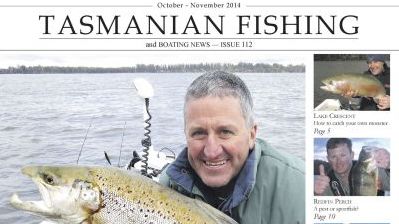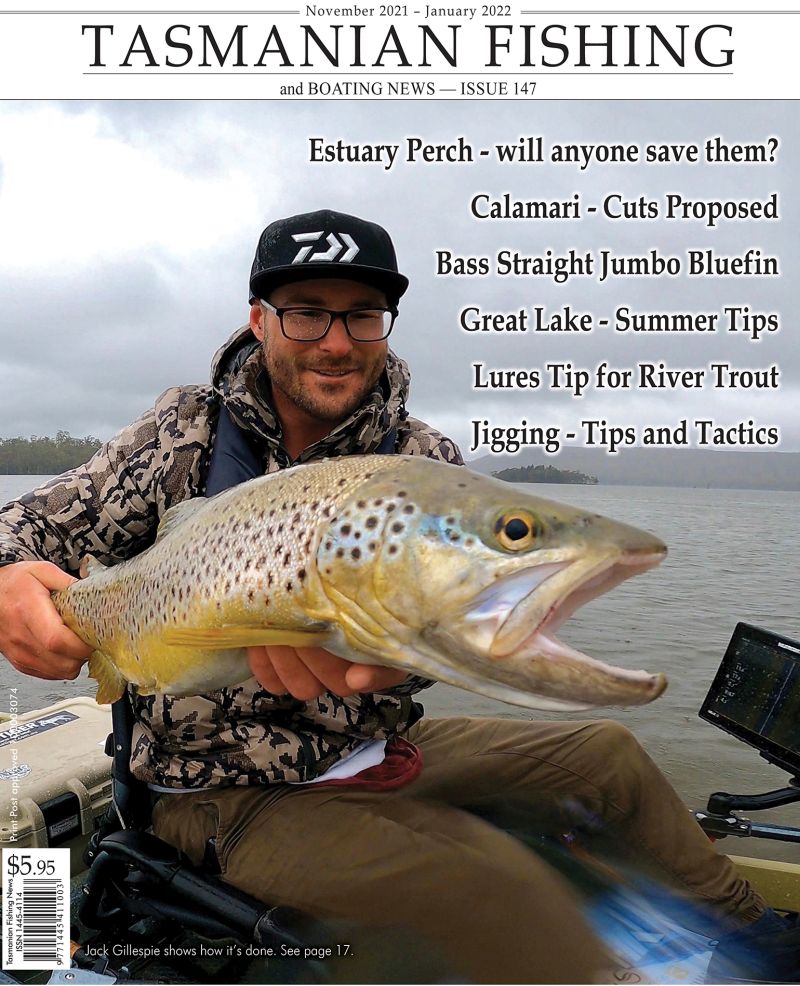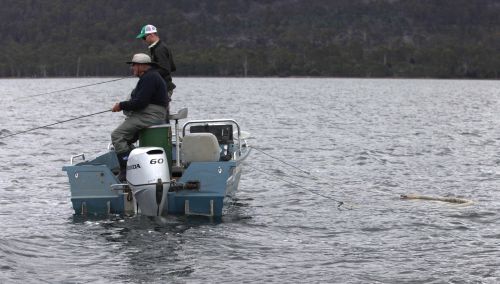From the Archives ...
Suggestions for Early Season Waters
Suggestions for Early Season Waters
by Sarah Graham
Many anglers are preparing for the opening of the new angling season on Saturday 7 August and it's shaping up to be another good one with the fishery in excellent health as a result of last year’s drought breaking rains. There are many great fishing locations around the State from which to choose for the opening weekend and early season fishing but here are a few suggestions.
Issue 112 October / November 2014
On sale in Tackle shops now - in Newsagents Thursday 9 October.
Contents include how Mike and Todd caught three fish in Lake Crescent that weighed 30 pounds, plus heaps more as below.
- Written by Stephen Smith - Rubicon Web and Technology Training
- Category: TFBN Back Issues
- Hits: 7637
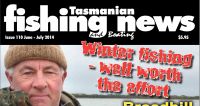 Back Issues Available
Back Issues Available
The June Edition (Issue 110) is available to read at Issuu - goto this link
- Written by Stephen Smith - Rubicon Web and Technology Training
- Category: TFBN Back Issues
- Hits: 7134
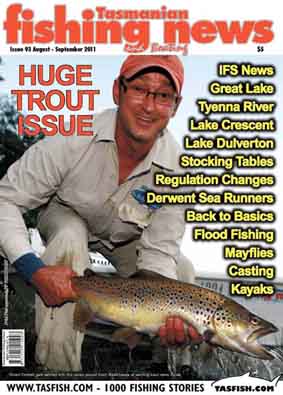 TFBN August 2011 - OUT NOW !
TFBN August 2011 - OUT NOW !
Wow, what an issue. This is the biggest issue of Tasmanian Fishing and Boating News we have done. I don’t know how many words are in here, but it must be a lot.
I would particularly like to thanks the Inland Fisheries Service for their contribution to this issue.
- Category: TFBN Back Issues
- Hits: 8405
Issue 90 February 2011
Trout Everywhere – Craig Rist
In Tasmania, trout have found their way into just about every trickle of water around the state. Many of these are very small tributaries of larger more popular rivers. The majority of the fish in these smaller streams are by no means monsters, with the average fish being somewhere between half a pound and a pound. Small brown trout dominate most of these small streams with the exception of a few rainbow only waters that are isolated from the dominant brown trout population.?The upper Mersey River between Lake Meston and Junction Lake is a classic example of this with its huge impassable waterfalls preventing any further migration of brown trout up stream.
- Category: TFBN Back Issues
- Hits: 10148
Issue 89, December 2010
Mythbusters – Excuses or fishy trends
Too windy, not windy enough, wrong wind direction. Too bright, too dull, too wet, too dry: excuses—or are they? Farmers and fishing guides have two things in common: firstly, they’re both in the weather everyday, working with Mother Nature. Secondly, both groups will tell you that the animals in their lives all react differently according to subtleties and vagaries of wind direction, atmospheric pressure and lunar cycles. In the case of fishing guides and experienced anglers, you can add a list of hatch and water level factors to the nuances of Mother Nature, vagaries which become plausible excuses at the end of a tough day. After the question of weather patterns and their affects on fishing came up on the FlyLife internet forum, I thought it might be a good time to do a bit of myth-busting with the aid of my fishing diary.
- Category: TFBN Back Issues
- Hits: 11495
Issue 88, October 2010
Smorgasbord – October and November
For fly fishers in Tasmania, October and November offers the greatest range of sight fishing opportunities for the season.
Tailing trout at Little Pine Lagoon, mayflies on the lowland rivers, sea-runners on the wild West Coast: just some of the classic Tasmanian sight fishing events found in the sometimes wild and windy, but always dependable October to November period. Tailing trout Leading on from early season action in September, tailing trout are the fly fishing highlight of October on the Central Plateau. The Nineteen Lagoons, on the edge of the Western Lakes, plays host to the most opportunities to chase tailing trout. Popular waters include the floodplains associated with lakes Augusta and Ada, though the peak events usually occur on the lagoons and tarns along the Little Pine River system, continuing downstream beyond the Nineteen Lagoons and onto Lake Fergus and the more accessible Little Pine Lagoon. Further down the plateau, and more action can be found in Pine Tier and Bronte lagoons. Feeding on caddis, snails, isopods and amphipods in shallow water, with heads grubbing along the bottom and tails waving in the air, hunting tailing trout can be very exciting. Both dry flies and wet flies can be successful, but persistence and patience are the key to catching tailing or mooching shallow water trout. Great fly patterns to try include Woolly Bugger variations, stick caddis imitations, snail patterns, Black Spinner dry flies and of course, the Red Tag. My own personal favourites include the Woolly Caddis, Simon’s Snail, MkII Woolly Bugger, Black Spinner and the Black and Peacock as described in my In Season Tasmania or Fly Cards books.
- Category: TFBN Back Issues
- Hits: 10858
Opening of the 2010-11 Trout Season
The 2010-11 angling season starts on Saturday 7 August, with the traditional opening of brown trout waters. Rainbow waters will remain closed until Saturday 2 October this year.
Get a Licence!
You require a current angling licence to fish at any open inland water in Tasmania (including farm dams on private property), except at a registered private fishery where you generally pay to fish. You can purchase or renew an angling licence by visiting a licence agent (at major tackle stores or any Service Tasmania shop). Licences can also be purchased or renewed online at www.ifs.tas.gov.au.
Angling licences range in price from a full season adult licence at $66.50 to a short term weekend licence for $20. The full season licence offers anglers the best value for money; being a 12 month licence with the opportunity to fish every day of the year; and with significant discounts for juniors (80% less at $12.00), pensioners (45% less at $36.50) and seniors (25% off at $53.00).
Other benefits include the convenience of being mailed a renewal form each year before the start of the season, which contains a durable licence card. The Service also targets full season licence holders with information and special offers such as the automatic entry into competitions to win prizes. This year, we are repeating the offer of free entry to the Salmon Ponds on presentation of a full season licence card and also a Voucher, mailed out with the renewal notice, for a free weekend licence to ‘Take a Mate Fishing’.
- Category: TFBN Back Issues
- Hits: 7909
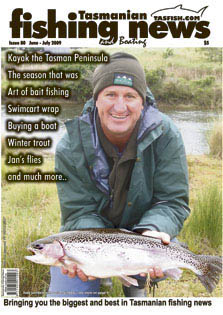 Tas. Fishing and Boating News - Issue 80
Tas. Fishing and Boating News - Issue 80
Issue 80 went on sale last week. Plenty of great winter reading.
14 years and still going strong. Getting heaps of back issue stories online now, so check out the back issues on the top right of your screen.
- Category: TFBN Back Issues
- Hits: 14825
Current TFBN
Click above for current issue content. The current issue of TFBN is extensive and topical. In Tackle Stores, Newsagents and by subscription.
Delivered to your door for $48 for 2 years (8 issues). To subscribe, send Mike $48 via www.paypal.com.au . (Basic instructions are here) The email is at Contact Us. Your address will be included from PayPal.
Or phone Mike with your c/c handy on 0418129949
Please ensure your details are correct, for Mike to organise delivery.
TFBN Newsletter Sign up Form
Why not submit an article ?
When you have finished for the day, why not have a brag about the ones that didn't get away! Send Mike an article on your fishing (Click here for contact details), and we'll get it published here. Have fun fishing - tasfish.com
Category Descriptions
Here is a list of all of the Article Categories. The number in Brackets, eg (13) is the number of articles. Click on Derwent River and all articles relating to the Derwent will be displayed in the central area.
Articles by Category
-
Rivers (3)
-
Saltwater and Estuary Fishing (149)
-
Kayak Fishing (34)
-
Lakes (1)
-
Great Lake (62)
-
Lake Leake (52)
-
Woods Lake (16)
-
Lake Augusta (11)
-
Huntsman Lake (13)
-
Lake Pedder and Gordon (10)
-
Lake Dulverton (5)
-
Lake Crescent (6)
-
Tooms Lake (10)
-
Lake Mackintosh (2)
-
Lake Barrington (5)
-
Little Lake (8)
-
Meadowbank Lake (5)
-
Lake King William (7)
-
Lake St Clair (2)
-
Western Lakes (12)
-
Arthurs Lake (35)
-
Lake Echo (7)
-
Four Springs (54)
-
Lake Sorell (7)
-
Lake Burbury (6)
-
Other Lakes (57)
-
Brushy Lagoon (18)
-
Little Pine Lagoon (5)
-
Penstock Lagoon (16)
-
Brumbys Creek (7)
-
-
Events (48)
-
Estuary Fishing (0)
-
Coastal Catches (46)
-
Super Trawler (46)
-
IFS, DPIPWE, MAST and Peak Bodies (435)
-
Commercial Interests (98)
-
Other (24)
-
TFBN Back Issues (8)
-
Fly Fishing (67)
-
Trout Fishing (252)
-
Meteorology and Weather (8)
-
Jan’s Flies (50)
-
Tuna Fishing and other Game Fishing (86)
-
Cooking Fish (19)
-
Fishing Information (1)
-
Fishing Books (8)
-
Videos (5)
-
Tackle, Boats and other Equipment (146)
-
World Fly Fishing Championship 2019 (2)
Popular Tags
windyty.com
Visit https://www.windyty.com/
Rubicon Web and Technology Training
Hello everyone, I thought it would be a good time to introduce myself.
My name is Stephen Smith and I have been managing the website tasfish.com since May 2009.
It has been an epic journey of learning and discovery and I am indebted to Mike Stevens for his help, support and patience.
I am developing a new venture Rubicon Web and Technology Training ( www.rwtt.com.au ). The focus is two part, to develop websites for individuals and small business and to train people to effectively use technology in their everyday lives.
Please contact me via www.rwtt.com.au/contact-me/ for further information - Stephen Smith.
From the Archives ... (last chance)
Tiny creeks and sea run trout - Christopher Bassano
Presented from Issue 105, August 2013
Christopher Bassano fishes over 250 days a year. This interview was recorded just before he headed off to fish for Australia in the World Fly Fishing Championships in Norway 14-17 August 2013.
I live on a small stream and at the start of the season I like to go off on a bit of a discovery mission and fish the headwaters of the creeks and rivers I feel an affinity with.
These small rivers include the St Pats, Meander, Forester, Little Forester and others. The further up you go on these rivers the clearer and lower the levels. They are often less affected by the rain and runoff and you get some good opportunities. Get as close to the source as you can and you will find some good dry fly fishing. Don’t limit yourself to those I have mentioned. Most headwaters will hold trout.
Read more ...
